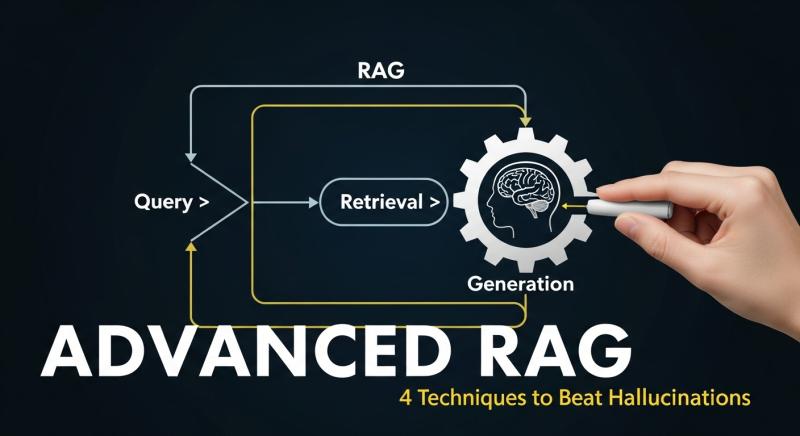
The Ultimate Guide to Advanced RAG Prompting Techniques for Better LLM Accuracy in 2025
Table of Contents (TOC)
- Introduction: RAG’s Evolution Beyond Basic Retrieval
- Technique 1: Multi-Query and Query Rewriting
- Boosting Retrieval with LLM Intelligence
- Technique 2: Self-Correction and Self-Verification (CoVe)
- The ‘Fact-Checker’ Layer for Generation
- Technique 3: Persona-Based and Expert Prompting
- Tailoring LLM Identity for Domain Expertise
- Technique 4: Few-Shot and Instruction-Tuning in Prompt Context
- Setting the Gold Standard for Output Format
- The Future Stack: Combining Prompting with GraphRAG
- Conclusion: Mastering the Art of RAG
1. Introduction: RAG’s Evolution Beyond Basic Retrieval
Retrieval-Augmented Generation (RAG) has cemented its status as the most effective method for building reliable, factual Large Language Model (LLM) applications. By grounding responses in external, verified knowledge, RAG drastically curtails hallucinations. However, as systems scale, developers realize that simple retrieval often isn't enough. In 2025, advanced RAG performance hinges not just on the data pipeline, but on sophisticated prompting techniques that intelligently instruct the LLM on how to use the retrieved context. These advanced strategies transform the LLM from a passive text synthesizer into an active, self-optimizing reasoning agent.
2. Technique 1: Multi-Query and Query Rewriting
A user’s natural language question is often sub-optimal for a vector database search. Advanced RAG uses the LLM itself to improve the search query.
- Multi-Query: The LLM is first prompted to generate 3 to 5 semantically different versions of the user's original question. All these queries are run against the vector database, expanding the chance of retrieving all relevant documents.
- Query Rewriting: For complex, multi-hop, or vague queries, the LLM is prompted to rephrase the input into a precise, self-contained search query. For instance, a query about "last year's update features" is rewritten to include the specific company and product names, greatly increasing retrieval precision.
This technique uses the LLM's language understanding before retrieval, ensuring the RAG system starts with the best possible context.
3. Technique 2: Self-Correction and Self-Verification (CoVe)
Basic RAG is a single-shot process (retrieve, then generate). Advanced RAG introduces a reflective loop to check factual consistency.
The most effective technique here is Chain-of-Verification (CoVe), which works in three steps within a single prompt:
- Generate: The LLM generates the initial answer using the retrieved context.
- Verify: The LLM is then prompted to break the answer down into a list of verifiable claims (a Chain-of-Thought step).
- Correct: The model runs a search for each claim and checks for supporting evidence in the retrieved documents. If a claim is contradicted, the LLM is instructed to revise the original answer for accuracy, acting as its own fact-checker.
This pattern drastically reduces the confidence of the LLM in fabricated answers.
4. Technique 3: Persona-Based and Expert Prompting
The LLM’s tone and scope of knowledge can be fine-tuned via the system prompt. This is crucial for domain-specific RAG applications (e.g., legal or medical).
- Persona-Based Prompting: The prompt dictates a specific identity and expertise: “You are a Chief Compliance Officer specializing in EU GDPR regulations. Based only on the retrieved compliance documents, explain the data retention policy.”
- Instruction-Tuning in Context: By instructing the model to only use expert terminology, or to only cite specific authoritative source codes, developers ensure the output quality aligns with the professional user's expectations, moving beyond generic replies.
5. Technique 4: Few-Shot and Instruction-Tuning in Prompt Context
To enforce a specific, consistent output structure, developers use Few-Shot Prompting within the RAG context.
- Example Integration: The prompt contains one or two examples of the desired Q&A format, complete with citations, tone, and bullet point structure, before the final user query. This dramatically improves the coherence of the final synthesized answer.
- Instruction Tuning: Explicit instructions, often using delimiters (e.g., XML tags), tell the model where the context begins and ends:
[CONTEXT]...retrieved snippets...[/CONTEXT]. Followed by: "Answer the user's question, strictly using the information inside the [CONTEXT] tags. If information is missing, state 'Insufficient Data'." This strict boundary increases factual adherence.
6. The Future Stack: Combining Prompting with GraphRAG
The cutting-edge in 2025 is integrating advanced RAG prompting with Knowledge Graphs (GraphRAG). GraphRAG converts unstructured document chunks into structured entities and relationships.
When combined with prompting, this enables:
- Multi-Hop Reasoning: The prompt can ask a complex question (e.g., "What products were affected by the Q3 software update, and who was the engineering lead?").
- The system uses the Knowledge Graph to traverse multiple entities (Q3 update → affected products → engineering team → lead person).
- The prompt then receives the structured path as context, allowing the LLM to generate an answer based on sophisticated relationship-based facts, something basic RAG struggles to do.
7. Conclusion: Mastering the Art of RAG
RAG is no longer a simple technique; it is a full-fledged system architecture. Achieving high LLM accuracy in production requires moving beyond simply appending retrieved documents. By mastering advanced prompting techniques—using the LLM's own intelligence for query optimization, self-correction, and domain specialization—developers can unlock the full potential of RAG, building applications that are not just fast, but highly reliable and trustworthy.
| 1. What is the goal of Query Rewriting in RAG? |
| Answer: Query Rewriting uses the LLM to rephrase the user's potentially vague question into multiple, highly optimized search queries, which significantly increases the retrieval system's chances of finding all relevant documents. |
| 2. How does Chain-of-Verification (CoVe) work? |
| Answer: CoVe is a self-correction technique where the LLM generates an initial answer, breaks it down into claims, verifies each claim against the retrieved context, and then revises the final answer based on the factual evidence. |
| 3. What is the advantage of using GraphRAG with RAG prompting? |
| Answer: GraphRAG provides RAG with structured relationship data (entities and connections) instead of just text chunks. This allows the LLM, through prompting, to perform complex multi-hop reasoning and answer questions requiring connections across multiple documents. |

